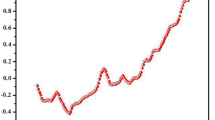The influence of the carbon sorbent surface structure and electron affinity of the molecule on the adsorption of poly- and heterocyclic aromatic hydrocarbons is evaluated. By adjusting the reducing ability of the surface of the carbon material, it is possible to control the adsorption process and the selectivity of the sorbent relative to condensed aromatic systems.


Similar content being viewed by others
References
S. I. Borovik and R. T. Askarov, “Evaluation of the content of benzo(a)pyrene in the air of the working zone in the production of carbon-containing refractories” [in Russian], thesis, Int. Conf. Refractories and Metallurgists, March 19 – 20, 2015, Moscow; Novye Ogneupory, No. 3, p. 10 (2015).
M. Brazkova and A. Krastanov, “Polycyclic aromatic hydrocarbons: Sources, effects and biodegradation”, Nauchni Trudove na Rusenskiya Universotet, 52, Series 10.2, 52 – 56 (2013).
Y. Kalmykova, N. Moona, A.-M. Strömvall, and K. Björklund, “Sorption and degradation of petroleum hydrocarbons, polycyclic aromatic hydrocarbons, alkylphenols, bisphenol A and phthalates in landfill leachate using sand, activated carbon and peat filters”, Water Res., 56, 246 – 257 (2014).
A. I. Soldatov, “Structure and surface properties of carbon materials” [in Russian], Vestnik Gosudarstvennogo Chelyabinskogo Universiteta. Seriya 4. Khimiya, No. 1, 155 – 163 (2001).
T. Tran-Duc and N. Thamwattana, “Modelling carbon nanostructures for filtering and adsorbing polycyclic aromatic hydrocarbons”, J. Comput. Theor. Nanos., No. 8(10), 2072 – 2077 (2011).
H. P. Boehm, “Some aspects of the surface-chemistry of carbon-blacks and other carbons”, Carbon, 32(5), 759 – 769 (1994).
N. Sirous, H. Fouad, and L. Max, “Adsorption of aromatic compounds by activated carbon: effects of functional groups and molecule size”, Adsorpt. Sci. Technol., 20(1), 1 – 15 (2011).
O. N. Chaykovskaya and L. V. Nechaev, Interaction of Polycyclic Aromatic Hydrocarbons with Organic Matter in Soil and Water Sediments [in Russian], Tomsk State University Publishing House, Tomsk (2017) 124 p.
A Practical Guide to the Methods of Quality Control of Raw Materials for the Production of Graphite Materials [in Russian], Mintsvetmet, Moscow (1982) 143 p.
A. P. Nechiporenko, Donor-Acceptor Properties of the Surface of Solid-Phase Systems. Indicator Method [in Russian], Lan’, St. Petersburg (2017) 284 p.
Author information
Authors and Affiliations
Corresponding author
Additional information
Translated from Novye Ogneupory, No. 2, pp. 65 – 69, February 2019.
Rights and permissions
About this article
Cite this article
Soldatov, A.I., Borovik, S.I. The Influence of Carbon Sorbent Surface Properties on the Adsorption of Poly- and Heterocyclic Aromatic Hydrocarbons. Refract Ind Ceram 60, 124–128 (2019). https://doi.org/10.1007/s11148-019-00321-1
Received:
Published:
Issue Date:
DOI: https://doi.org/10.1007/s11148-019-00321-1




